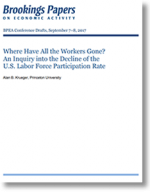Beyond Shovel-Ready: The Extent and Impact of U.S. Infrastructure Jobs
This report sheds new light on the widespread contributions that infrastructure jobs make to the nation’s economy, including their importance at the metropolitan level.
For decades, policymakers have called for more spending on America’s infrastructure to stimulate job growth.
In 1982, President Ronald Reagan wanted to raise the federal gasoline tax by a nickel to generate “real, worthwhile work.”
President George H. W. Bush was widely quoted in 1991 after signing a federal transportation law that, he said, “could be summed up in three words: jobs, jobs, jobs.”
Similarly, the American Recovery and Reinvestment Act of 2009 focused on job preservation by pumping billions of dollars into “shovel-ready” transportation, energy, and water projects.
In his latest State of the Union address, President Barack Obama noted how “first-class jobs gravitate to first-class infrastructure” through new ladders of opportunity into the middle class.
In many ways, this focus is understandable in Washington and beyond given the recent economic struggles facing the country. Construction jobs, after all, accounted for one-third of the jobs lost since the start of the Great Recession, and they are still 1.5 million below their pre-recession level despite three years of steady increases.
Spending on infrastructure also attracts attention from policymakers owing to the large multiplier effects these projects can often have on the overall economy, which can
lead to gains in productivity and employment.
Yet, as policymakers continue to direct attention to infrastructure, they do not always identify the exact types of jobs supported by these investments. By limiting infrastructure employment to construction alone, and viewing it largely in terms of stimulus spending, policymakers have not considered the breadth of infrastructure jobs found across the U.S. economy.
Key Findings
An analysis of occupational employment data for the nation reveals that:
- In 2012, 14.2 million workers were employed in infrastructure jobs across the country, accounting for 11 percent of national employment.
- Infrastructure occupations tend to offer more equitable wages compared to all occupations nationally, paying over 30 percent more to workers at lower ends of the income scale.
- More than 80 percent of workers employed in infrastructure occupations typically have short- to long-term on-the-job training, but only 12 percent hold a bachelor’s degree or higher and generally need less education to qualify for these jobs.
- Infrastructure occupations are projected to increase 9.1 percent during the next decade, including the need to replace more than 2.7 million workers.
What’s Related




Favorites





